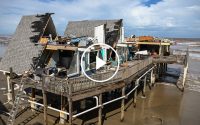Behind beauty that attracted billionaires, Maui also had housing for workers that will be tough to replace.
The wildfires that leveled the town of Lahaina on Maui wiped out shops, restaurants and a hotel built more than century ago, burning across some of the most spectacular and wealthiest enclaves of the state. High-profile billionaires including Oprah Winfrey, Peter Thiel and Jeff Bezos all have homes on Maui.
But the deadly blaze also destroyed something less visible yet vital to this island’s economic survival: modest houses and apartments where many workers running Maui’s booming tourism industry lived.
The destruction in Lahaina has highlighted Maui’s longstanding challenge with housing for the people who work in its hotels and on its golf courses, without whom the island could not function as a beloved destination for visitors from around the world.
“We already had a housing crisis,’’ said Leslie Wilkins, president of the Maui Economic Development Board. “This grossly exacerbated it.”
The Lahaina blaze, which so far has killed 53 people and destroyed hundreds of buildings, follows a tumultuous time in Maui’s economy.
During the early stages of the pandemic, in 2020, tourist visits to Maui County, which includes Maui and smaller neighboring islands, essentially ground to a halt and unemployment hit 27 percent.
Even as tourism has recovered in Maui and in Hawaii broadly, the recovery has been complicated by an increasing shortage of work force housing.
Maui was one of the nation’s hot pandemic housing markets, where wealthy buyers from the mainland realized they could work remotely from Hawaii. They bought houses sight unseen, often with all cash.
Housing prices in Maui County, which had already been on the rise since the financial crisis, increased about 35 percent from 2019 to 2022.
For years, affordable housing developments have failed to get approved on Maui because of neighborhood opposition and bureaucratic red tape, said Justin Tyndall, assistant professor of economics at the University of Hawaii’s Economic Research Organization. A large percentage of the housing stock is also used for vacation rentals, further winnowing supply.
The fire damage, Mr. Tyndall said, “is going to cause a lot of people to confront our demons in terms of housing.”
Some of the county’s 87,000 workers were forced out of Maui by these rising costs and went looking for jobs on the U.S. mainland. Las Vegas has become such a popular destination for the recent Hawaiian diaspora that it is known as the ninth island.
In 2022, Hawaii had the highest cost of living of any state, according to data from the Council for Community and Economic Research. Hawaii imports the vast majority of its food, making everyday groceries expensive. The cost of building materials is also high, presenting another challenge to the rebuilding efforts
On Thursday, Governor Josh Green said in an interview with CNN that finding permanent housing for people displaced by the fires is “going to be one of our largest lifts.” He said as many as 1,700 structures had been destroyed.
He noted that the state was already under an “emergency order” related to the housing shortage. “But now of course things are made worse.”
Some workers who have managed to stay in Maui’s inflated real estate market have been living in houses, built decades ago, which they inherited from family members, said Don Harris, a real estate agent in Lahaina.
Some of these “legacy” houses have had as many as 12 people bunking together in two or three bedrooms.
Jasmine Joao, a paralegal at an estate planning law firm in Maui, said in a telephone interview that the fires could disproportionately affect Native Hawaiian families in terms of their ability to recoup losses on their homes.
She said many Native Hawaiian families in Lahaina will probably get much less in compensation because a lot of their homes were passed down through generations and are paid off, so the owners don’t have mortgages and aren’t required to have insurance.
“Our office is preparing for a lot of calls in the next few days,” she said.
The fire may be the final straw for families in Maui’s increasingly unequal economy.
Many of these legacy houses are not insured or insulated, making the cost of rebuilding them to meet current codes prohibitive, Mr. Harris said.
“There are going to be a lot of families who cannot rebuild,” he said. And there are some people who might not want to rebuild on Maui.
Robbie Wares, 64, has lived for decades in a Lahaina neighborhood known as Kiawe Camp, near a Safeway grocery store. Her home of 20 years had been destroyed in the fire.
On Thursday, while sitting in an emergency shelter in a gymnasium, she thought aloud about what was next for her — and for her neighbors who had lived in what she said were poorly maintained apartments that she doubted were habitable even before the fire devastated the town.
She bought her home, which her brother-in-law and sister own partially, for around $150,000 about two decades ago. She spent $20,000 on a new roof, and she still owes $120,000 on it.
She guessed the land is worth about $1 million now. But she doesn’t know where she’d go if she sold the property. She moved to Maui half a century ago from Massachusetts, she said.
“I can’t move back to the mainland,” she said, tearfully. “I can’t take the cold winters. I won’t do it.”
Shawn Hubler and Amy Qin contributed reporting.


